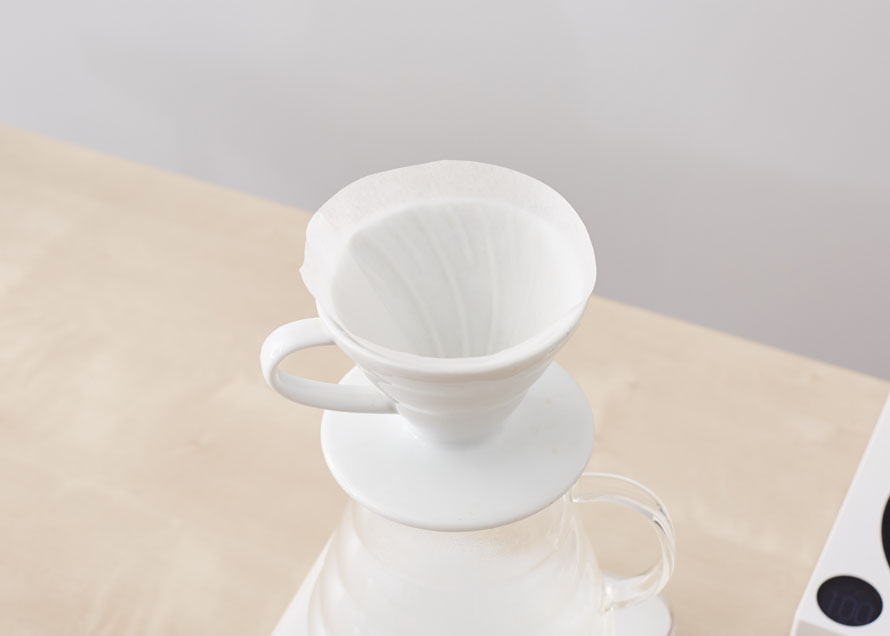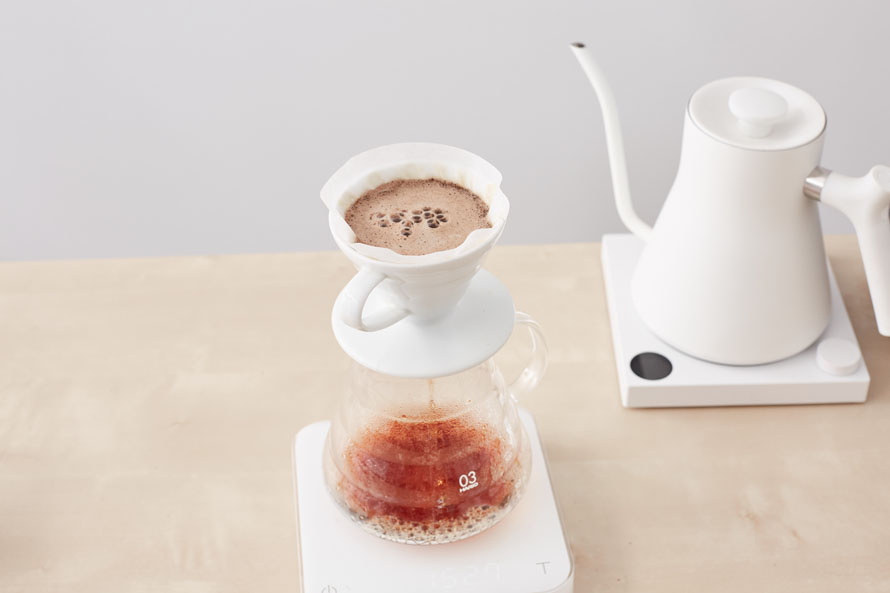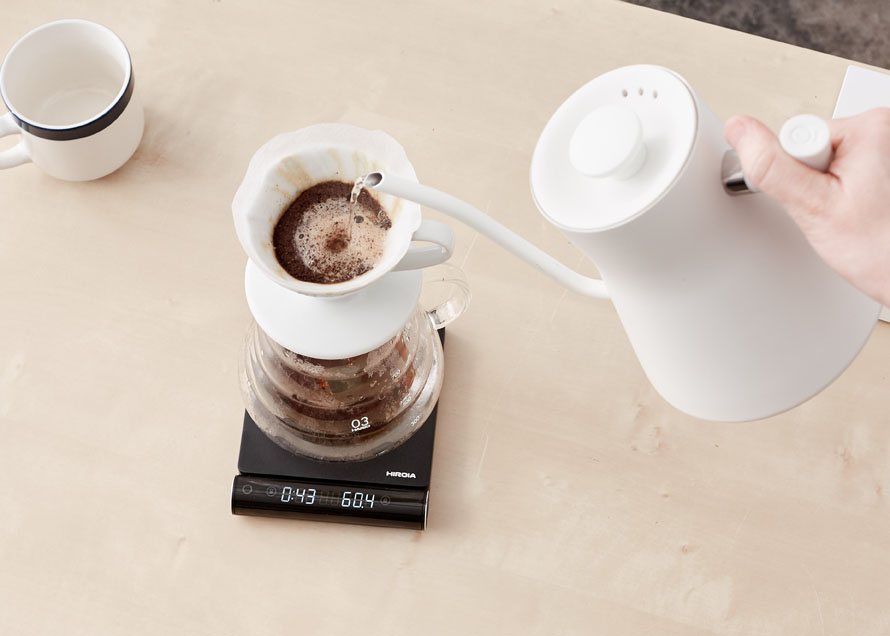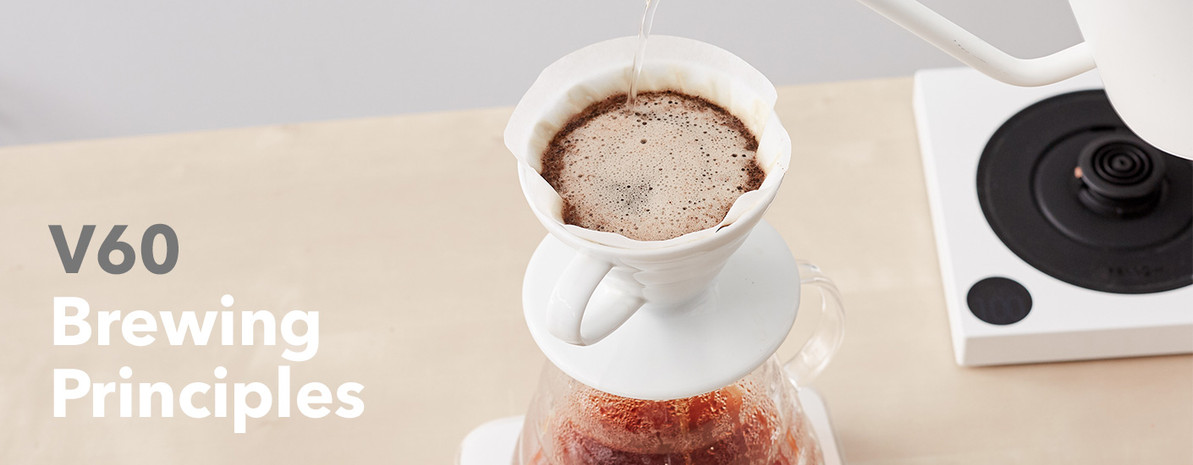Understanding Coffee Brewing with Your V60
How to brew with your V60 dripper, using an explanation of extraction, strength, and the variables you can use to make better coffee.
Depending on where and when you got into coffee, it’s likely that Hario’s V60 was the first pour over dripper to catch your eye. By now the brewer is synonymous with specialty coffee, and for good reason—dynamic and capable of producing dazzling cups of coffee, your V60 is designed to encourage delicious extractions that masterfully balance flavor clarity and satisfying body. But, that sort of coffee doesn’t just happen without a little background knowledge about how coffee brewing works, and how those principles apply to this specialty coffee stalwart. So let’s take a look at your dripper and the near-magic that is coffee brewing taking place inside of that cone; we’ll talk a little about how extraction works, how to judge your extraction to make informed decisions about dialing-in your recipe, and how to work with your V60 to get the coffee that you want out of it every time.
If you haven’t already, check out our Basic Brewing Principles guide where we detail the fundamentals of good coffee, good water, and good recipes. Or, if you’re interested in these concepts in a general sense instead of specifically for your V60 dripper, take a gander at our Intermediate Brewing Principles.
Brewing is Extraction
No matter how you make coffee, brewing can be more specifically understood as the process of extraction. A series of physical and chemical interactions are set off when coffee and water mix—water washes oils and superfine particles from the surface of your ground coffee, and then over time pulls flavor out of those grounds by dissolving (via dissolution and hydrolysis) most of the extractable compounds in the roasted beans. As all of this happens water holds everything it’s extracted in solution, which is what we call brewed coffee! The water-soluble compounds that were dissolved will make up the flavor of your beverage, while the insoluble compounds that were washed from the surface of your grounds will help determine the body and texture of your coffee.

The chemical make-up, and thereby the flavor and texture, of your brewed coffee will change constantly throughout the extraction process. This is because different chemical compounds in your roasted coffee (like organic acids, simple sugars, and more complex carbohydrates) all dissolve and extract at different and predictable rates; the first few drips out of your V60 will be highly concentrated, excessively rich, and full of lively organic acids, while the end of your brew will be dilute, astringent, and contain difficult-to-dissolve compounds (like those more complex carbohydrates) that require ample time and temperature to dissolve. You could do this experiment at home for yourself! Collect 6 different cups to brew onto and brew using your usual V60 recipe is, but move the brewer onto a new cup every 30 seconds; you can taste side by side how different each part of the extraction is from the overly-strong beginning of extraction to the faint and astringent tail end. The predictability of the rate and order in which these flavors dissolve means that we get some influence over what our coffee tastes like, as well as giving us insight about how to judge our extraction as either under-extracted (we removed too little of the soluble material), over-extracted (we removed too much of the soluble material), or ideally extracted (we removed just the right amount of the soluble material).
How to Judge Your Extraction
If you spend much time diving into topics like brewing theory and extraction science you’ll quickly find loads of numbers and probably even a formula or two for measuring your brewed coffee. While quantitative data can be a helpful way to communicate precise information from one person (with the necessary tools to measure and understand the measurement) to another person (with the same tools and understanding), any coffee professional should be able to tell you that you don’t taste numbers, measurements, or extraction percentages, you taste coffee! So, if the flavor of our brewed coffee is defined by the level of extraction we reach, how do we know if our brew is over-extracted, under-extracted, or just right? By taste, of course! We’re able to judge our relative extraction by using a few flavor guidelines that can be readily tasted in brewed coffee.
Under-extracted coffee will likely taste sour, salty, or overbearingly acidic. The early stage of extraction contains most all of the acids that will be extracted, as well as some bitter compounds (like caffeine) that can be overwhelming when left overconcentrated and unbalanced by the flavors that will extract later in the brew.
Over-extracted coffee will likely taste bitter, weak, and feel unpleasantly astringent. Many of the flavors extracted late in a brew are bitter in taste, pushing the flavor balance in that direction quickly. Also, there’s very little extractable material in ground coffee late in the brewing process, so the liquid coffee flowing out of your brewer at this point will be thin and dilute, contributing to the lower strength of an over-extracted brew.
Ideally extracted coffee should be balanced and flavorful, with your V60 capable of achieving both a satisfying texture and an acidity that complements the flavors of your brew. This can mean sweet and brimming with fruit flavors, deep and rich with chocolatey goodness, or complex and alluring with savory complexion.

If you’re not a confident taster right now that’s totally okay! Tasting is a skill you can learn, and with a little trial and error you’ll be able to start judging your extraction accurately enough to make educated decisions about how to adjust your recipe for a better brew.
The Importance of Strength
Extraction isn’t the only factor that will define how your V60 coffee tastes in the cup, strength will have a significant influence as well. Our ability to taste coffee (or any beverage) well relies on flavors being at an appropriate concentration—too little flavor in solution and our brains can’t be bothered to make out the flavors accurately, leaving us to experience the drink as dilute and unfulfilling, while too much concentrated flavor will leave our taste buds uncooperative and overloaded with muddy and harsh flavors.
With your V60, assuming that your dose and grind setting are in the generally accepted range for pour over brewing, your strength should almost always end up in the palatable range. However, if you want more control over making your coffee stronger or more mellow, we’ll cover some variables below that will allow for you fine-tune your strength to be juuust right.

Mastering Your V60
There are dozens of variables that go into the perfect brew. While they’ll all have some influence on the resulting cup of coffee, only a handful of them will have a substantial impact on the quality of your extraction. One of the biggest benefits of brewing with a V60 is the level of control you get over so many of those variables; using the same roasted coffee you can achieve a wide variety of quality extractions, some highlighting acidity and clarity, some focusing on body and depth of flavor, but hopefully always centered around the even extraction of a whole dose of beans.
This won’t be a step-by-step walkthrough of how to brew coffee (there are tons of V60 tutorials all over the internet), so try to think of it instead as a guide to understanding the relationship between the variables you can influence, and how changing each variable might affect your final cup.
Brew ratio is the amount of roasted coffee and water you use to brew a single extraction. Most V60 recipes out there encourage you to use 1g of coffee for every 15–17ml of water, or you might often see the recommendation for 60g of coffee per 1 liter of water used for any drip brewer. The ratio you choose will affect both extraction and strength significantly. For this variable, extraction and strength will be inversely correlated, meaning that the higher the extraction you achieve through your brew ratio the lower the total potential for strength becomes. Managing this ratio in your V60 can be simple enough—using more brew water (relative to your coffee dose) will result in coffee with a higher extraction and a weaker strength, while using a smaller volume of water will result in stronger coffee with less overall extraction.
The Grind setting that you choose will also have a significant impact on extraction yield and a lesser impact on potential for strength, but in this instance the results will be directly correlated. As you grind finer and finer you increase the rate at which you’ll extract the coffee, and you’ll also slow down the speed at which water is able to move through the bed of grounds and the brewer; thanks to the large outlet for brewed coffee on the brewer, and because the Hario V60 filters are so thin, there’s very little mechanically to slow the flow of water in the V60 itself, so your ground coffee works as the primary flow restrictor for the water you use for brewing. Expect to start with coffee ground on the fine-side of medium (think coarser than table salt, finer than kosher salt) and be prepared to adjust this variable for extraction before any other. Always remember that your grind setting will need to scale with your batch size as well! Your particle size should get larger as your dose gets larger (and vice versa), so brewing an 18g dose for yourself will require a finer grind than brewing 30g to share with a friend.

The Temperature of your water will relate directly to your rate of extraction, cooler water extracting slower and hotter water extracting faster. The general standard for brewing says to use water 195°F–205°F (90.5°C–96°C), but there are lots of folks who prefer hotter or colder water for various reasons. Because the V60 comes constructed out of so many different materials, you might find a certain temperature works better or worse for your brewer specifically—a ceramic V60, for example, if not thoroughly preheated, will act as a heat sink and sap energy directly out of your coffee slurry. This version of the brewer might benefit from a higher temperature in your kettle. On the flip side, a plastic V60 does amazingly well at temperature stability, allowing you to use water in your kettle that is closer to your ideal extraction temperature.
Your total Contact Time in the V60 will be related not only to your grind setting, but also directly influenced by the rate at which you introduce water to your brewer. A low-and-slow pouring style will let water mosey its way through the bed of coffee, extending your contact time and likely producing a slightly higher-extraction brew. Conversely, an aggressive pouring style out of the kettle and a large volume of water on top of your bed of grounds will increase the flow rate of your brew water, lending itself to a lighter-and-brighter extraction. Regardless of how you implement this in your brewing, always remember that more time means more extraction. Learning to balance your brew ratio, grind setting, and water flow rate is really the key to managing your V60’s contact time and, ultimately, your total extraction.
Get Brewing!
You can read all of the brewing theory out there and it wouldn’t make a difference if you never get your hands on a kettle, so get brewing! Hopefully now with a little understanding of extraction and strength, guidelines for how to taste and assess your brew, and an overview of the variables you can adjust with your V60 brewer, you’re prepared to dive in and make a little magic in the pursuit of the perfect mug of coffee.
Happy brewing, y’all.



